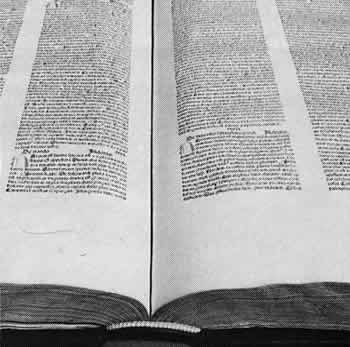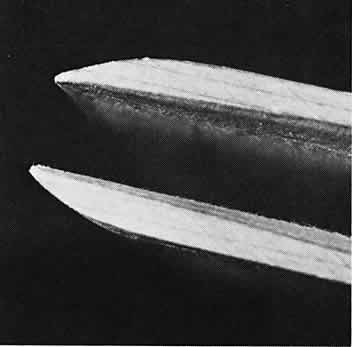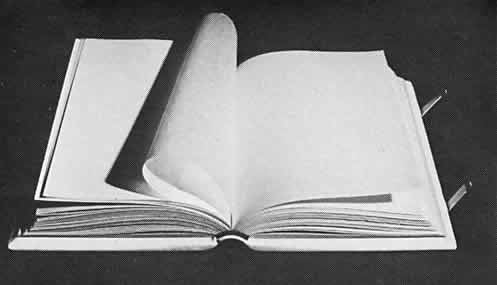The Restoration Rebinding of Speculum Naturale by Vincent of Beauvais, and the Subsequent Development of Several Options for Conservation Rebinding Structures Based on Details Found During the Restoration
By Bruce R. LevyAt the Harry Ransom Humanities Research Center, I undertook the restoration of a two volume set of Speculum Naturale, by Vincent of Beauvais, a work printed in Strassbourg in 1481, and bound in Nuremberg in approximately 1493. The bindery that produced these wood board "Nuremberg" bindings is one of the numerous anonymous binderies that occasionaly worked for Anton Koberger. This bindery can be identified only by the group of finishing tools isolated to this particular bindery, and designated as "K-118" in Kyriss' Verzierte Gotische Einbande Im Alten Deutschen Sprachgebiet.

| 
|
| Fig. 1 | Fig. 2 |
The curatorial decision was to restore the bindings, retaining as much of the original material and format as possible. The volumes had been previously restored. The restoration leather deteriorated quickly while the original leather displayed a greater degree of durability. ( figures 1 & 2 )

| |
| Fig. 3 | |

| 
|
| Fig. 4 | Fig. 5 |
After preliminary documentation the pastedowns were removed. I then removed the remains of the original cover leather along with the deteriorated restoration leather, and separated the two. The original fragments were consolidated on the grain side with Klucel-G in isopropanol. The grain surface then had japanese paper applied with paste to hold it together while the deteriorated corium layer was removed. The flesh side was now also consolidated with Klucel-G. (figures 3, 4 & 5 )

| |
| Fig. 6 | |

| 
|
| Fig. 7 | Fig. 8 |
During the cleaning and repair of the wooden boards some interesting details were found. As with many early wooden board books, the vellum spine lining was extended and the flaps were attached to the board to strengthen the board-to-text attachment. One would usually find the vellum flaps attached to the inside of the board. Although the previous restorer had removed them, fragments of the original flaps were found. However, in this case, the flaps were split by two cuts, and of the resulting three tabs, the outer two were attached to the outside of the boards while the center one was passed to the inside and attached to the inner board surface. During restoration the same structural elements were replicated. ( figures 6, 7 & 8 )

| 
|
| Fig. 9 | Fig 10 |
This interesting variation kept the point of the beveled board edge at the apex of the spine fold of the first and last section. As the inside of the board was absolutely flat, another critical detail, we had a slightly rounded structure, with no shoulder, no visible spine swell, with pages that opened to the spine fold from the first to the last page and with none of the usual page flexion one finds with the traditional rounded and backed structure (figure 9), or even the minimally shouldered hard board conservation structure. (figure 10 )

| |
| Fig. 11 | |

| 
|
| Fig. 12 | Fig. 13 |
The books were recovered and the original leather cover and spine pieces were inlayed into the new leather. Even with the original sewing, the books now exhibited a remarkable flexibility and flow due to these mentioned elements. (figures 11, 12 & 13) A cut-away model was fabricated to illustrate the superstructure. (figure 14)

| 
|
| Fig. 14 | Fig. 15 |
Although I am sure that others like these two books must exist, I have been thus far unable to find other books in the HRHRC collection that exhibit this unique combination of structural elements.
This structure held for me many possibilities, and I began to construct models using these details applied to different book conservation requirements. This structure, which we call "K-118", for want of a better name, is applicable not only in conservation rebinding, but for restoration of original bindings as well. There are, however, some important structural elements which must be utilized.
First, after sewing either with supports or un-supported, the spine of the text is pasted or glued. Here one has the choice of an adhesive binding, or if sewn on a Japanese paper concertina, a non-adhesive structure. The degree of round that is finally given is dependent on the amount of spine swell after gluing-up. The important point here is that after rounding with the fingers and, if needed, a gentle hammering, the text is dropped into a backer, not with a shoulder's space protruding, but right up to the spine fold and supports. Here it is gently squeezed and guided by hand until the spine swell is translated into the round. Now the text block will be completely flat, with no shoulder, and no swell. (figure 15) The spine can now be set with another coat of paste or glue. At this point a headband can be sewn, either to be laced into the boards, or un-laced.

| 
|
| Fig. 16 | Fig. 17 |
The next step is to cut the boards, and shape them if this is desired. The important step here is to leave the inner gutter edge un-beveled, and the outer edge gently rounded to continue the round of the spine. This places the point of the inner board edge right at the spine fold of the first and last sections. (figure 16) I frequently use boards made of laminated conservation board, shaped to give a refined profile, but with the feel and mass of wooden boards. The conservation board gives the element of dimensional stability, but wooden boards could also be used. (figure 17) If there are supports one can now lace the text block to the boards in any manner desired. Since a split-flap vellum spine liner will be attached to the boards inside and out with glue, leave about 1/32" set back of the boards towards the foredge to allow a better openability.

| |
| Fig. 18 | |

| 
|
| Fig. 19 | Fig. 20 |
If the headband is to be laced-in, now is the time to do it. Next the vellum liner is adhered to the spine between panels or supports, leaving enough extra material for the flaps. For all but large books, I use manuscript vellum (parchment) that is on the heavy side, rather then the stiff covering vellum. The choice here will come from experience. I soften the vellum or parchment with paste where it will come into contact with the spine and apply it with a mixture of paste and PVA, using a bit of paste on top to facilitate rubbing down to insure complete adhesion. Little wedges are then taken out of the flaps. (figure 18 )
The center flap of the three is passed to the inside. The outer two flaps are attached first and then the inner flap is glued and the board closed on it to correctly position it. Here again I use a paste-PVA mixture, but it should not be too wet as it will cause the vellum to stretch and upon drying will pull the board back towards the spine. (figures 19 & 20) When dry one can obscure the ridge of vellum by paring, filling with paper and sanding. Covering can be with virtually any usable material. Another aspect of this structure is that theoretically, the cover material can break down, but because of the vellum split-tabs, the structural integrity will be maintained. The structure is fully functional even without cover material.

| 
|
| Fig. 21 | Fig. 22 |

| |
| Fig. 23 | |

| 
|
| Fig. 24 | Fig. 25 |
I have completed several models, and used this structure on various artifacts with very satisfying results. The first model was one based on a folio sized book in alum-tawed pig, with foredge clasps and laced-in headbands. (figures 21 & 22) The next model was designed for use with a restored illuminated manuscript, where the text was sewn on a concertina that was allowed to extend to the foredge as an interleaf, and interleaves of the same japanese paper between each bifolium, also extended to the foredge. This model was meant as one possible approach to a manuscript that was so convoluted that pigmented pages being turned would abrade each other if there was no protective interleaf. (figures 23, 24 & 25 )

| 
|
| Fig. 26 | Fig. 27 |

| |
| Fig. 28 | |

| 
|
| Fig. 29 | Fig. 30 |
The third model was a reference style ¼¼leather binding sewn on tapes with vellum tips. (figures 26 & 27) The reference style of tape sewn book has proven to be remarkably durable, giving an extreme degree of flexibility, with the capacity to return to round upon closing. Still another is a model for a photographic album which allows the photograph to be supported by floating in a tabbed piece of paper, which slides into a stiff mat-page. This page is sewn into the K-118 structure which allows the pages to remain flat, without flexion, and without the stub or tab binding used in most historical photo album structures. (figures 28, 29 & 30)
The K-118 structure was used on several incunables. Euseubius Chronicon, 1483 was sewn on a concertina with double flexible linen cords and alum-tawed goat with a tight-back. The two illustration show both the pleasing visual aspect and the structures remarkable flexibility. (figures 31, 32 & 33)

| |
| Fig. 31 | |

| 
|
| Fig. 32 | Fig. 33 |
Sermones De Laudibus Sanctorum, 1489 was bound in alum-tawed pig with foredge clasps to restrain the wedge shape it had previously assumed. (figure 34) The opening of this volume shows the intrinsic flow of this structure. (figure 35)

| 
|
| Fig. 34 | Fig. 35 |
This structure has successfully been used for the restoration of original Victorian cloth publisher's bindings where the text block was brittle card stock. The original edge bevel of the boards was directly utilized by the K-118 structure and allowed the book to be used without apparently changing its format, while flexion of the brittle pages was no longer a problem. (figures 36 & 37 )

| 
|
| Fig. 36 | Fig. 37 |
Once again: for restored vellum manuscripts, for older books much used for reference, for books with stiff brittle pages, for photographs that are to remain in bound format, even for modern fine bindings, any book that would benefit from a rounded, unbacked swell-less structure that opens to the spine fold from the first to the last page, the K-118 Structure is a viable and in many cases desirable option for conservation rebinding and restoration.